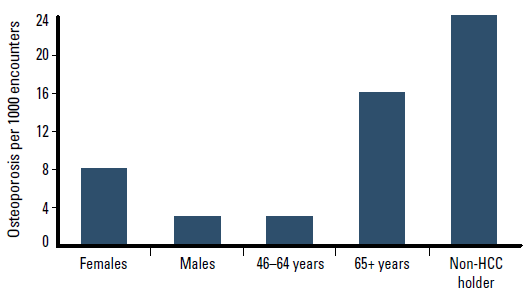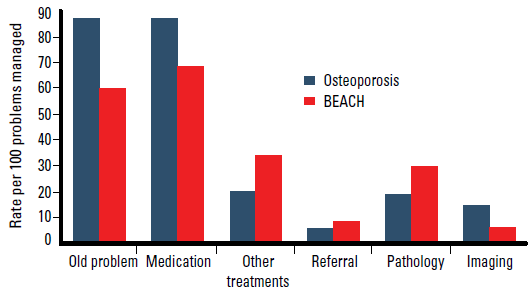From April 2010 to March 2011 in BEACH, osteoporosis was managed at a rate of 6 per 1000 general practice encounters, suggesting an average 708 000 osteoporosis patient-doctor encounters per year nationally.
Women accounted for 80% of the 570 patients at encounters for osteoporosis, being managed at a rate of 8 per 1000 female encounters, significantly more often than males (3 per 1000). Patients aged 45–74 years accounted for 51% of all osteoporosis encounters, and patients aged 75 years and over accounted for 47%. The management rate was significantly higher among patients aged 65 years and over (16 per 1000 encounters with patients in this age group) compared with other age groups. As would be expected, osteoporosis was managed significantly more often among patients who held a Commonwealth Healthcare Card (HCC), and less than one-quarter of patients did not hold an HCC (Figure 1).

Figure 1. Patient group specific management rates of osteoporosis
Management
Significant differences between management of osteoporosis and of all problems at BEACH encounters over this study period are shown in Figure 2. Osteoporosis was managed most often as an ongoing problem for the patient, and new cases were rarely recorded. Medications rates were higher than the BEACH average while rates of other treatments performed were lower than average. Referral rates and pathology orders were also lower for osteoporosis. Imaging rates on the other hand, were higher than the BEACH average, and 80% of these were densitometry tests.

Figure 2. Comparison of osteoporosis management with total BEACH problems
Medications prescribed, advised or provided
The most common medication was the combination product alendronate/cholecalciferol, which was recorded at a rate of 13 per 100 osteoporosis problems managed, and accounted for 15% of these medications. Alendronate and risedronate each accounted for 14% of medications, and strontium ranelate made up 10% of medications for osteoporosis.
Conflict of interest: none declared.
Acknowledgements
The authors thank the GP participants in BEACH and all members of the BEACH team. Financial contributors to BEACH in 2010 and 2011: Australian Government Department of Health and Ageing; Australian Government Department of Veterans' Affairs; AstraZeneca Pty Ltd; Bayer Australia Ltd; CSL Ltd; GlaxoSmithKline Australia Pty Ltd; Merck, Sharp & Dohme (Aust.) Pty Ltd; Novartis Pharmaceuticals Australia Pty Ltd; Pfizer Australia; Sanofi-Aventis Australia Pty Ltd.